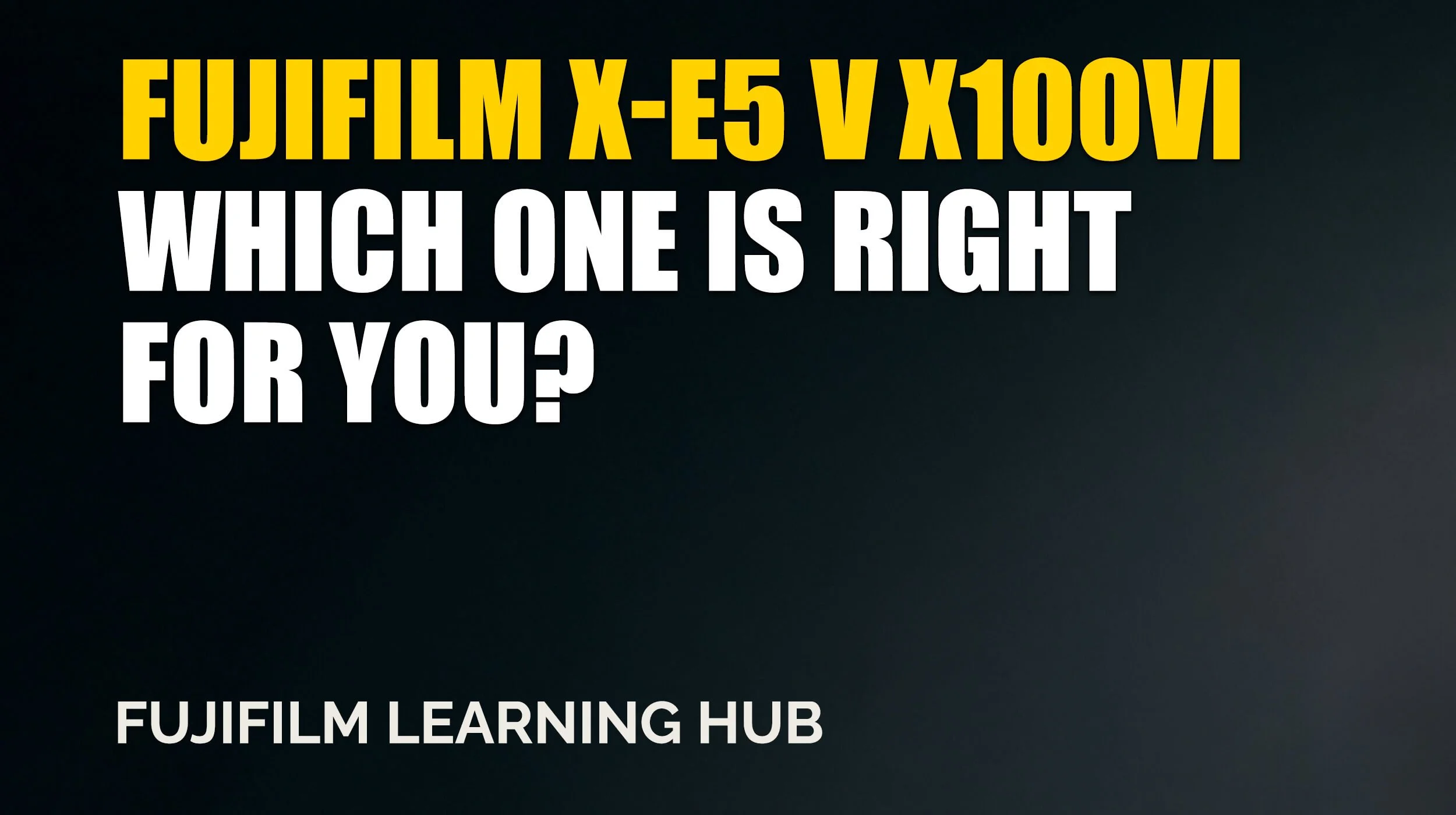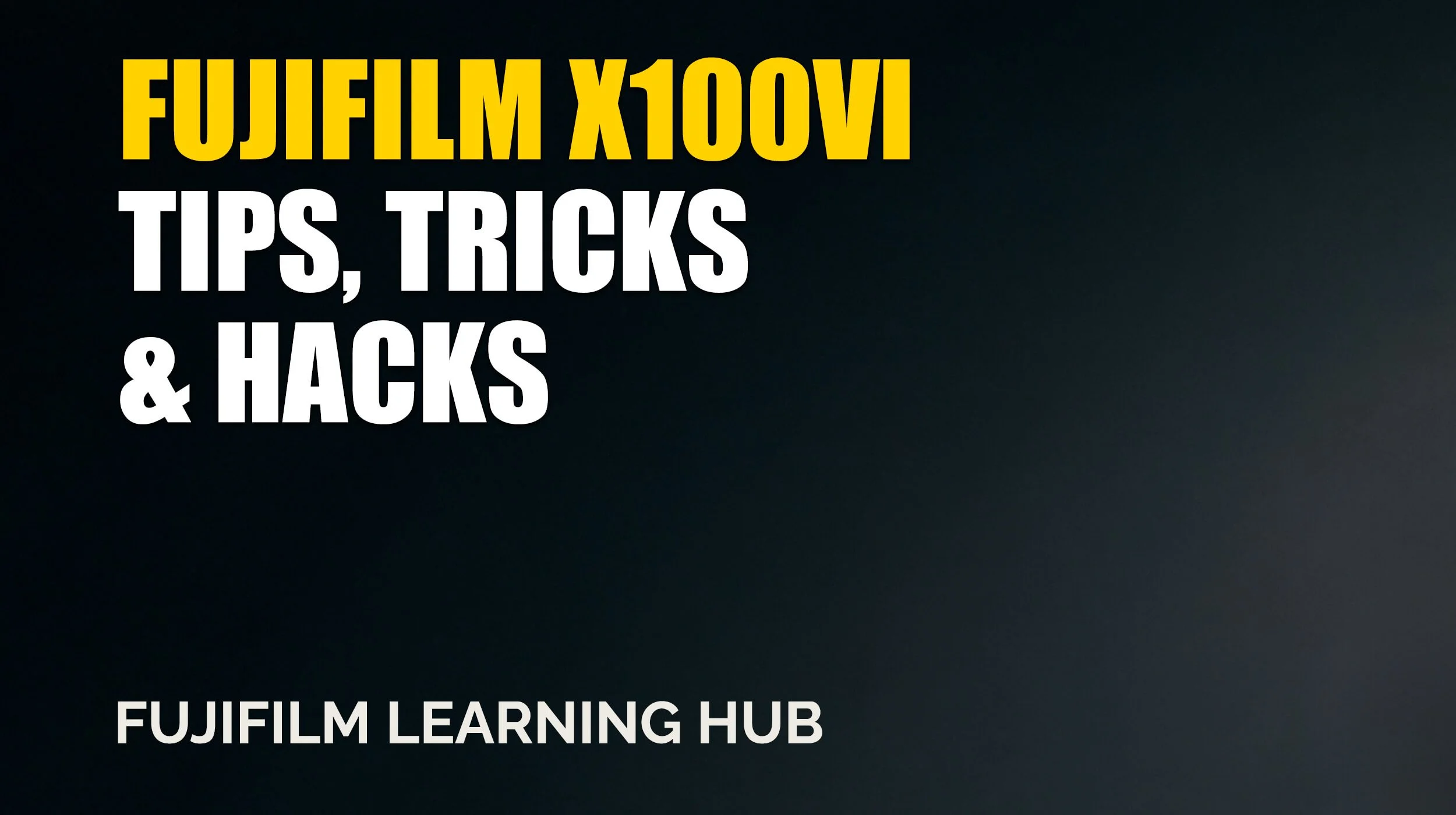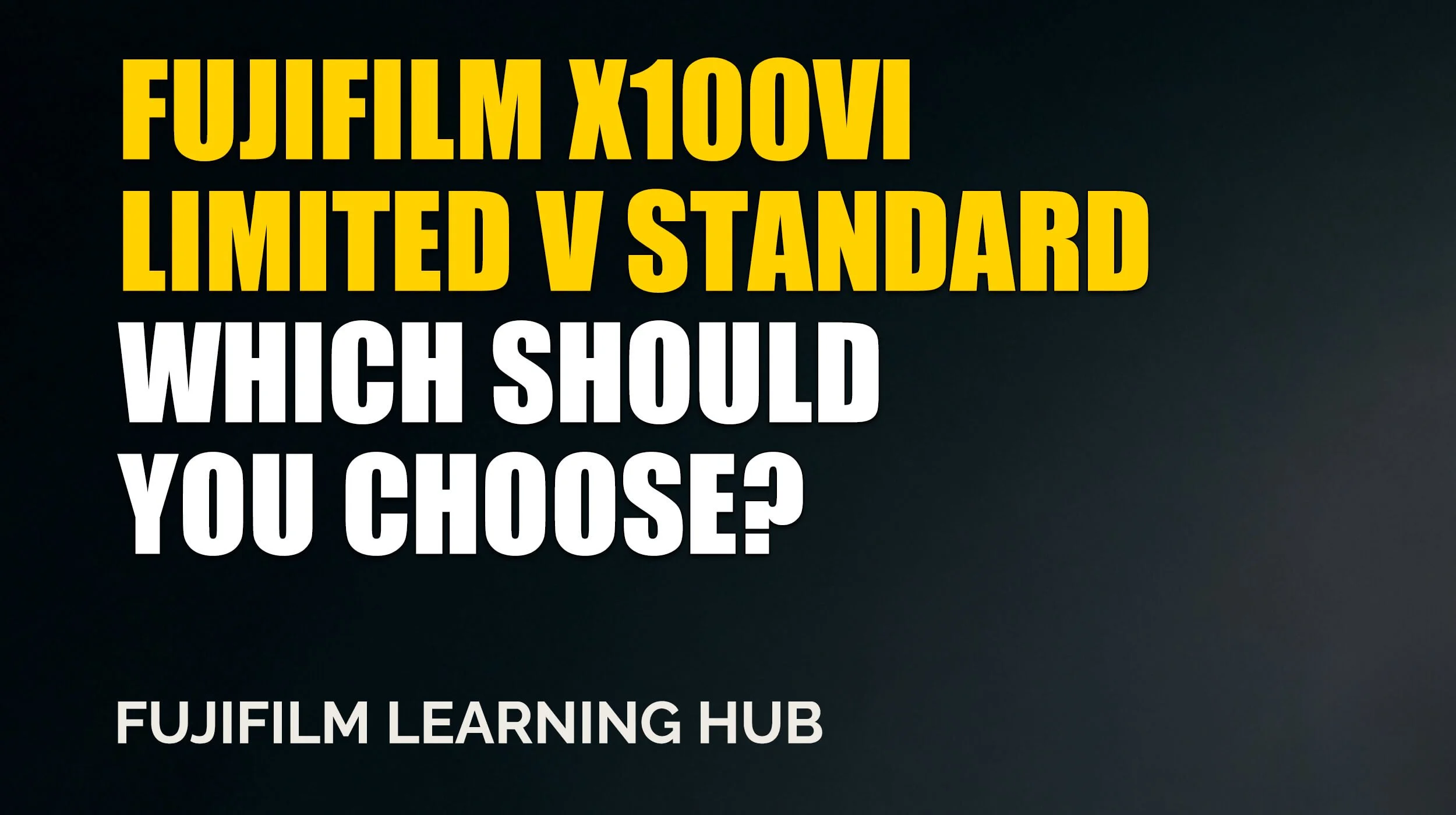The Difference Between the Fujifilm X100V and X100VI
This article is part of my Fujifilm Learning Hub.
A growing collection of real-world guides, camera setup tips, lens suggestions by use-case, practical assignments, and buying advice with examples.
Prefer to see everything I write—brand-agnostic pieces on documentary & street work, reviews, tips, and the business of photography? Browse F/16 Click.
Fuji X100VI vs X100V: What's Actually New?
The Fujifilm X100V is one of those rare cameras that somehow became more than just a camera. It turned into a bit of a cult object: part fashion accessory, part street shooter's dream. And then came the X100VI.
Now, whenever Fujifilm releases a new X100-series camera, the internet tends to light up. It happened with the X100V, and now it's happening again. So it's only fair to ask: what’s actually different between the Fujifilm X100V and X100VI? And is it worth upgrading if you already have the V?
Before we get too far into personal impressions and real-world use, it helps to lay things out clearly. Below is a quick comparison of the key specs between the Fujifilm X100V and the X100VI.
On paper, the changes might seem incremental, but they do add up in meaningful ways — depending on how and what you shoot.
| Feature | Fujifilm X100V | Fujifilm X100VI |
|---|---|---|
| Sensor | 26.1MP X-Trans CMOS 4 | 40.2MP X-Trans CMOS 5 HR |
| Image Processor | X-Processor 4 | X-Processor 5 |
| ISO Range | 160–12,800 (expandable to 80–51,200) | 125–12,800 (expandable to 64–51,200) |
| In-Body Image Stabilisation | No | Yes (up to 6 stops) |
| Autofocus Points | 425 phase detection points | 425 phase detection points |
| Film Simulations | 17 (including Classic Chrome, Acros) | 20 (adds Reala Ace and others) |
| Continuous Shooting | 11 fps mechanical, 20 fps electronic | 11 fps mechanical, 20 fps electronic |
| Video Recording | 4K/30p, 1080/120p | 6.2K/30p, 4K/60p, 1080/240p |
| Lens | 23mm f/2 (35mm full-frame equivalent) | 23mm f/2 (same lens design) |
| Viewfinder | Hybrid OVF/EVF | Hybrid OVF/EVF |
| Rear LCD | 3.0" tilting touchscreen, 1.62M dots | 3.0" tilting touchscreen, 1.62M dots |
| Built-in ND Filter | 4 stops | 4 stops |
| Battery Life (CIPA) | ~350 frames | ~310 frames |
| Connectivity | Wi-Fi, Bluetooth 4.2 | Wi-Fi, Bluetooth 5.0 |
| Weight (with battery) | 478g | 521g |
| Dimensions (mm) | 128 × 75 × 53 | 128 × 75 × 55 |
| Weather Sealing | Yes (with optional filter adapter) | Yes (with optional filter adapter) |
Same shape, new heart
At a glance, you’d be forgiven for thinking nothing’s changed. The X100VI looks almost identical to the X100V. Same minimalist styling. Same hybrid viewfinder. Still that lovely 35mm-equivalent f/2 lens. It even fits most of the same accessories.
But under the hood, that’s where things start to shift.
The X100VI now carries Fujifilm’s new 40-megapixel sensor, the same one found in cameras like the X-H2 and X-T5. That’s a big jump from the 26 megapixels in the X100V.
Whether or not you need 40MP is a fair question, and we’ll come back to that, but it’s the biggest leap the series has ever taken in terms of resolution.
The sensor upgrade (and what it actually means)
More megapixels mean more detail, right? Technically, yes. If you like cropping in post or printing big, the X100VI gives you that extra latitude. Files are larger, yes, but they’re also sharper and more flexible, especially if you’re editing RAW.
That said, not everyone loves this change.
Some folks find 40MP a bit much. It’s more demanding on storage. It can slow down your editing workflow. And realistically, a lot of everyday shots — street photos, travel snaps, casual portraits — don’t need that many pixels.
So while the X100VI’s sensor is clearly “better”, it’s not automatically more enjoyable.
For some, the 26MP of the X100V hits a real sweet spot.
IBIS: The one feature that changes everything (quietly)
If there’s one thing about the X100VI that you might not notice at first but will come to really appreciate, it’s the addition of IBIS, or in-body image stabilisation.
This is the first X100 camera to have it. And it matters more than the press releases make it sound.
Handheld at 1/15 of a second? Doable. Shooting in low light without having to bump ISO too much? Much easier. Video? Noticeably steadier. It’s one of those upgrades you don’t think you need... until you do.
IBIS also helps when you’re shooting film simulation JPEGs straight out of camera (which, let’s be honest, a lot of us do with this camera). It gives you the confidence to slow things down without worrying about blur creeping in.
My X100VI Review:
Autofocus: Not dramatically different, but noticeably better
The X100VI benefits from the newer X-Processor 5, which in simple terms means faster autofocus and better subject tracking. If you’ve ever felt the X100V was a touch hesitant in tricky lighting, or when trying to lock onto moving subjects, you’ll likely appreciate the upgrade.
That said, it’s not a night-and-day difference. The X100V already had very decent autofocus. But in edge cases — low contrast scenes, fast-moving kids or pets, or face detection in a crowd — the VI feels a bit more decisive.
And again, paired with IBIS, the newer system just feels more refined overall. Less jittery. A bit calmer, if that makes sense.
Film Simulations and JPEG output
This is where things get a little more subjective.
Both cameras shoot Fujifilm’s film simulations — Classic Chrome, Acros, Eterna, and so on. But the X100VI gets some newer options, including Reala Ace. Whether you love that or not depends on your taste, of course, but more options is rarely a bad thing.
Also, with 40MP, those JPEGs have more flexibility. You can crop a bit without sacrificing too much. Some users find the extra detail gives the simulations even more bite — sharper edges, better colour transitions. Others might say it’s almost too sharp, especially for nostalgic looks. That’s really up to how you shoot.
Video capabilities: Still not the main story, but improved
Let’s be honest — most people aren’t buying an X100 camera for video. But if you do want to shoot clips now and then, the X100VI is better equipped. It offers 6.2K video and better rolling shutter performance than the V.
There’s still no headphone jack, and it’s not a vlogging powerhouse, but it’s no longer an afterthought either. Think of it as a much more capable B-camera, or a travel-friendly tool for those who want to shoot a bit of everything.
Official Fujifilm X100VI Release Film:
Handling and feel: Pretty much the same (for better or worse)
This is both good news and... maybe slightly boring news.
The X100VI handles almost exactly like the V. If you’re already familiar with the button layout, menus, and viewfinder, you’ll feel right at home. That hybrid viewfinder remains one of Fujifilm’s most unique features, and it’s still lovely to use.
On the flip side, IBIS does make the body ever so slightly thicker and heavier. It’s not dramatic (at all), but you might notice it in side-by-side comparison. The VI also tends to run a bit warmer during extended use, which is worth noting if you shoot a lot of video.
Fuji X100VI vs X100V: Which one should you get?
Let’s not pretend there’s a perfect answer.
If you already own an X100V and love it, the X100VI isn’t a must-upgrade. It’s better in ways that might not dramatically change your day-to-day experience - unless you’ve been craving IBIS or doing a lot of cropping and post-work.
On the other hand, if you’re just now entering the world of X100 cameras, the VI is probably the most complete version yet. More resolution, stabilisation, faster performance, and a bit more future-proofing.
But the V still holds its charm. It’s lighter, simpler, and, depending on second-hand prices, maybe the more accessible option.
In fact, it’s one of the few cameras that’s actually increased in value straight after launch. Not bad for a digital compact.
Mastering the Fujifilm X100VI Look
Recipes, Reflections & Tools for Monochrome and Colour Photography
More than just a set of JPEG recipes, this is an all-in-one digital field guide to the Fujifilm X100VI.
Packed into 230 A5-formatted pages, this PDF delivers deep technical insights and hands-on guidance covering everything from Dynamic Range and Clarity to X RAW Studio, White Balance tricks, and creative colour use.
With over 50 original monochrome and colour recipes — plus a full breakdown of every built-in film simulation — you’ll also find cheat sheets, setup walkthroughs, tips for creating and backing up your own looks, and a guide to using light and composition more effectively in-camera.
It’s a true companion — structured for easy navigation, formatted perfectly for tablets, and designed to go wherever your camera goes.
Whatever it is, the way you tell your story online can make all the difference.
Final thoughts (for now)
So, what’s the actual difference between the Fujifilm X100V and X100VI?
It’s not just one thing. It’s a collection of small but meaningful changes — sensor, stabilisation, autofocus, video — that add up to a more refined experience.
But whether it’s worth it depends entirely on your shooting habits.
What you value.
How you shoot.
Or honestly, how much you just like having the latest and greatest.
Either way, you’re not going wrong.
The X100 series remains one of the most joyful camera experiences out there. And the VI, for all its quiet changes, only strengthens that reputation.
Frequently Asked Questions
-
That depends on your needs. If you shoot handheld in low light, crop a lot, or want the latest autofocus and stabilisation tech, then yes — the X100VI brings real improvements. But if your X100V still feels like a great fit, there’s no urgent reason to switch. It’s still a fantastic camera.
-
The biggest differences are the new 40MP sensor, the addition of in-body image stabilisation (IBIS), improved autofocus, and enhanced video capabilities. The X100VI is a more powerful camera under the hood, but the shooting experience remains quite familiar.
-
Yes. The X100VI is the first in the X100 series to include IBIS, offering up to 6 stops of stabilisation. This makes it much easier to shoot handheld in low light or at slower shutter speeds.
-
The X100VI benefits from Fujifilm’s latest X-Processor 5, which delivers faster, more confident autofocus performance. It tracks subjects better, especially in challenging lighting or with moving targets.
-
Absolutely. The X100V continues to produce excellent images and has aged incredibly well. It might not have the latest internals, but for many photographers, its simplicity and image quality are more than enough.
-
Both cameras produce stunning JPEGs with Fujifilm’s signature film simulations. The X100VI’s files are sharper and more detailed, thanks to the higher resolution sensor. It also offers newer simulations like Reala Ace. That said, some prefer the slightly softer, more organic feel of the X100V’s 26MP files.





















A quick, reliable way to save and restore your Fujifilm camera settings using the Tether App — perfect for upgrades, repairs, or syncing two bodies.